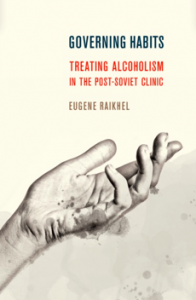© 2018 Svetlana BARDINA
2018 — №1 (15)
Keywords: addiction treatment, alcohol addiction, alcoholism, clinic, coding, medical anthropology, narcology, post-Soviet economy, post-Soviet medical system, suggestion
Abstract: Governing habits: Treating Alcoholism in the Post-Soviet Clinic is a comprehensive study of the post-Soviet narcology. Based on field research in a number of Russian narcological hospitals, the author analyzes clinical practices and their meaning to clinicians and patients.
 Review on: Eugene Raikhel. Governing habits: Treating Alcoholism in the Post-Soviet Clinic. Ithaca and London: Cornell University Press, 2016.
Review on: Eugene Raikhel. Governing habits: Treating Alcoholism in the Post-Soviet Clinic. Ithaca and London: Cornell University Press, 2016.
One of the main issues raised in this book is the questionable status of such methods of treatment as khimzashchita and kodirovanie. Although the legitimacy of these methods is highly contested, both khimzashchita and kodirovanie are prevalent in Russian health institutions. The author tries to explain their popularity with reference to the set of meanings given to the drug or to the technique of coding.
It is demonstrated that the efficacy of khimzashchita is based not on its chemical features, but on the patients’ belief that this – the most physically invasive – method has great potency. Therefore, it is not always clear whether khimzashchita is psychological or physiological method. However, the majority of Russian physicians are sure that the implant manipulates on bodily level, even when a placebo is used. The author suggests that this view is connected with the history of narcology in the Soviet Union. Soviet narcology traces its origin back to Pavlov’s physiology; within Pavlov’s theory of conditioning, behaviour is understood physiologically. Thus, since khimzashchita changes patients’ behaviour, it is considered to be operating on bodily level.
Kodirovanie could also be popular due to the set of meanings ascribed to this practice. The author compares kodirovanie and other types of suggestion with magic. According to Levi-Strauss, ritual healing is based on a threefold experience: that of the shaman, that of the sick person, and that of the public producing collective support. Narcological practices also require a special experience of a physician, of a patient, and some public support. The author shows which ‘ritual’ techniques make it possible.
In addition to the analysis of contemporary narcological practices, the author provides a detailed description of the history of narcology in Russia, and of its social and economical context.
References
Collins, P. (1986) Learning from the Outsider Within: The Sociological Significance of Black Feminist Thought, Social Problems, Vol. 33, No. 6, p. 14-32.
Grossman, G. (1977) The Second Economy of the USSR, Problems of Communism, Vol. 26 No. 5, p. 25-40.
Ledeneva, A. (1998) Russia’s Economy of Favors: Blat, Networking, and Informal Exchange, New York: Cambridge University Press.
Levi-Strauss, C. (2001) Strukturnaia antropologiia[Structural anthropology], Moscow: Eksmo-Press.
Marotta, V. (2012) Georg Simmel, the Stranger and the Sociology of Knowledge, Journal of Intercultural Studies, Vol. 33 No. 6, p. 675-689
Pels, D. (1999) Privileged Nomads, Theory, Culture & Society, Vol. 16 No. 1, p. 63-86.
Raikhel, E. (2016) Governing habits: Treating Alcoholism in the Post-Soviet Clinic, Ithaca and London: Cornell University Press.
Vakhshtayn, V. (2015) Delo o povsednevnosti: sotsiologiia v sudebnykh pretsedentakh [The case of everyday life: sociology in judicial precedents], Moscow, Saint-Petersburg: Tsentr gumanitarnykh initsiativ [Center of humanitarian initiatives].
Winch, P. (1996) Ideia sotsial’noi nauki i ee otnoshenie k filosofii[The Idea of a Social Science and Its Relation to Philosophy], Moscow: Russkoe fenomenologicheskoe obshchestvo [Russian society for phenomenology].